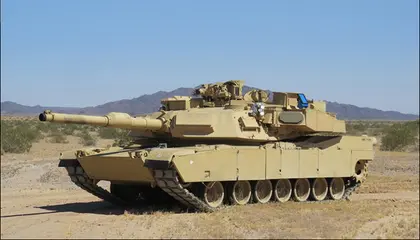The legendary Abrams is believed to be one of the best tanks in the world. Developed in 1979, it has been in service in the U.S. since 1980. Initially, it was named XM-1, and later renamed after General Creighton W. Abrams Jr.
The main battle tank Abrams M1 was developed by Chrysler Defense to replace the outdated M60, ensuring greater reliability, repairability, durability and – above all – fighting capacity. No other U.S.-made tank still surpasses it in terms of technical features. In 1998, the magazine Military Ordnance rated M1A2 the world's second-best main battle tank after the German Leopard 2А5. It is used by the armies of Poland, Egypt, Morocco, Saudi Arabia and other countries.
JOIN US ON TELEGRAM
Follow our coverage of the war on the @Kyivpost_official.
The Abrams fought in such operations as Desert Storm in the Persian Gulf, Enduring Freedom in Afghanistan and Iraqi Freedom in Iraq.
During Desert Storm, they effectively destroyed Soviet-made Т-72s. According to a 1992 report by the U.S. Government Accountability Office, only 23 Abrams tanks out of nearly 2,000 used in the operation were lost: seven of them were destroyed by friendly fire and two were blown up not to let them fall into the enemy's hands. There, the U.S. forces used the M1A1 modification, and the tank has since undergone a series of modernizations.
The tanks earmarked for Ukraine will not be those from U.S. stocks but newly manufactured latest-generation tanks. Robert Abrams, the retired army general who commanded the U.S. forces in Korea and whose father the tank was named after, said in a comment that the difference between the M1A1 and the latest modification "is like the difference between a wire telephone and the iPhone you're holding in your hand."

ISW Russian Offensive Campaign Assessment, January 21, 2025
Besides, the modernized version is greatly more lethal than the M1A1.
"In terms of lethal power, durability and mobility the M1A2 surpasses everything that Russia has on the battlefield," stressed General Abrams.
How the Abrams performs on the battlefield
The Abrams is armed with an M256 120mm smooth barrel gun developed by Germany's Rheinmetall and produced in the U.S. under license. This gun fires both subcaliber armor-piercing and cumulative projectiles. The heads of armor-piercing projectiles are normally made of tungsten alloys, but some contain depleted uranium. The latter have a very high piercing rate and cause heavy destruction.
Gathering an extremely high speed, projectiles with depleted uranium can pierce the thickest armor. Furthermore, depleted uranium is pyrophoric: it can self-ignite upon impact. Fragments blaze up just from contact with air, setting the fuel tanks on fire or causing ammo detonation.
The Abrams is really a perfect tank killer that can destroy tanks of any model used by any country.
Russian hysteria
Russia's reaction to the announced provision of Abrams tanks to the Ukrainian army could easily be described as hysterical. It seems quite absurd that those who destroy Ukrainian cities can suddenly become so concerned about the health of Ukrainians who could be affected by depleted uranium.
But weapons containing depleted uranium are classified as conventional – not nuclear or chemical – and are freely used by armies. In terms of radioactive exposure, an armor-piercing shell head is no more hazardous than a piece of steel or copper.
Of course, it is radioactive, but its 4.51-billion-year half-life makes the substance almost harmless as the intensity of ionizing radiation of radioactive material is inversely proportional to the half-life period.
The designers paid special attention to the crew's survival, placing the 40-round ammo compartment in the rear part of the turret. In the event of detonation, special panels deflect the shockwave from the crew, thus making their chances to survive a lot higher. By contrast, the crews of Soviet-made and even modern Russian-made tanks are doomed in that case.
The Abrams is believed to be one of the heaviest-armed tanks in the world. Its multilayer combined armor is similar to that of the British Chobham. The armor on the new modifications also has depleted uranium content which makes it practically invulnerable to any antitank weapons. The front turret and chassis armor can withstand 700mm armor-piercing subcaliber shells and 850mm cumulative shells.
Also, the automatic fire extinguishing system instantly reacts to any ignition inside the tank.

Electronic "stuffing"
Even in the first modification, the fire control system was so good that it achieved 90 percent precision in hitting a moving target from 2,000 meters. It was later improved by integrating new systems and devices in the single inter-vehicular information system (IVIS).
The Abrams has a ballistic fire control system with an inbuilt range finder and thermal imager. Sensors send data to the computer system that automatically builds the trajectory to the target on the basis of range data, vehicle and gun tilt, barometric pressure and even wind direction. All the gunner has to do manually is feed the munition type and outside temperature.
In the latest modifications, the driver's infrared night vision system has been replaced with a comprehensive thermal imaging system.
The Abrams uses the AVCO Lycoming 1,500 horsepower gas turbine engine. Durable and frugal, it can run on gasoline, diesel, kerosene and other types of fuel.
Should the engine need to be repaired, the design provides for replacing about 70 percent of parts without having to remove the engine from the body. In the event the whole engine needs to be replaced, it takes about 60 minutes.
There was an interesting episode recently on the frontline – the crew of a Ukrainian T-64 tank gave it the call sign "Abrams" just for fun. The Russian invaders were impressed, to say the least. In intercepted radio calls they were heard warning their tank crews that the Ukrainians were already using U.S. tanks. Well, now their fears are about to materialize.
You can also highlight the text and press Ctrl + Enter










